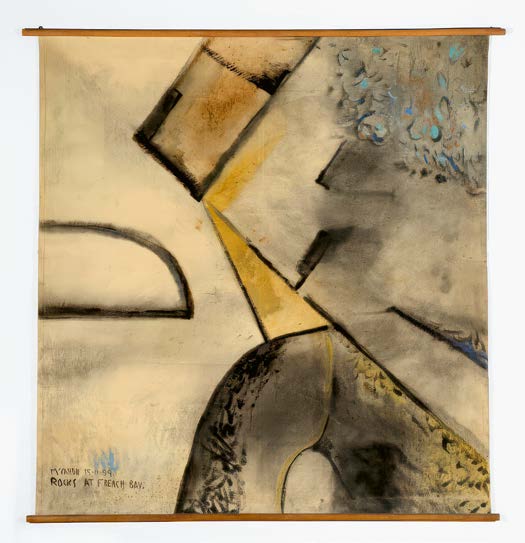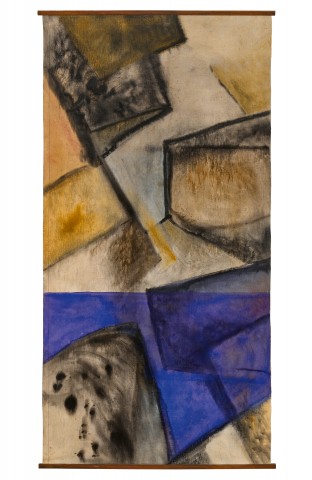Fish Rock, c.1959
Colin Mccahon
oil, tempera and ink on unstretched canvas
180.0 x 90.0 cm
signed and inscribed with title and medium on timber hanging rod verso: McCAHON FISH ROCK TEMPERA N.F.S
Molly Ryburn, Auckland, New Zealand, a gift from the artist
Martin Browne Fine Art, Sydney
Private collection, Sydney, acquired in 1993
The Group Show, Canterbury Society of Arts Durham Street Art Gallery, Christchurch, New Zealand, 8 – 23 October 1960, cat. 29 (nfs)
The Group Loan Show, Robert McDougall Art Gallery, Christchurch, New Zealand, 27 October – 6 November 1960, cat.8
(In 1960 The Group held its usual annual exhibition at the C.S.A and a selection of paintings from it was shown four days later at the Robert McDougall Art Gallery.)
Bloem, M., and Browne, M., Colin McCahon: A Question of Faith, Stedelijk Museum, Amsterdam & Craig Potton Publishing, New Zealand, 2002, pp. 193, 253
Simpson, P., Colin McCahon: There is Only One Direction, Vol.1 1919 – 1959, Auckland University Press, New Zealand, 2019, pp. 290, 350
Colin McCahon Online Catalogue, cat. CM000127: https://www.mccahon.co.nz
1.jpg

27 March 1961
A strong and vibrant painting not seen in public since 1960, Fish Rock, c.1959 belongs to a small group of works by Colin McCahon painted during late 1959 which share a common medium, a common reference to a particular landscape (French Bay in the Manukau Harbour, Auckland), and a roughly similar size (although with variable widths). Other titles in the group include Rocks at French Bay (two versions, Auckland Art Gallery and private collection) and French Bay with Fish Rock and Headland (Gow Langsford Gallery, previously known as French Bay). In size, materials and medium this group is also related to two major slightly earlier series – the monumental, 16-panel The Wake, 1958 (Hocken Collections) and 8-panel Northland panels, 1968 (Te Papa Tongarewa) – which McCahon made soon after his watershed visit to the United States in March-August 1958.
Although the primary focus of McCahon’s visit to America was to study museum practices (he was deputy director of Auckland Art Gallery), he also relished the opportunity to explore major institutions and dealer galleries all across America. It was his first extensive exposure to international art since visiting the National Gallery of Victoria in 1951. Among the artists mentioned as highlights in his letters from the States were Mondrian, Diebenkorn and Tomioka Tessai in San Francisco; El Greco, Tintoretto and Renoir in Washington; Cézanne and Picasso in Philadelphia; Rothko and Hofmann in Baltimore; Juan Gris, Pollock, de Kooning and Kline in New York; and Gauguin in Boston. Much of his prodigious output in the year after his return from America (with the exception of The Wake) made up a major exhibition at Gallery 91 in Christchurch in October 1959: Colin McCahon: Recent Paintings November 1958 – August 1959. Notably, the show included the Northland panels, Northland triptych, 1958; the innovative Elias series, 1959 (various private collections and Auckland Art Gallery), and many other important individual works such as Cross, 1959 (Auckland Art Gallery) and Tomorrow will be the same but not as this is, 1958 – 59 (Christchurch Art Gallery). In the final weeks of 1959, after his big Christchurch show, McCahon returned for the last time to the land-and-seascapes of Titirangi and French Bay to make the small, tight group that includes Fish Rock. He subsequently moved to central Auckland early in 1960, a transition which initiated a new phase of his work – the geometric abstraction of the Gate series.
2.jpg

and Publication Trust
Many of the changes in McCahon’s practice from the prolific year after his return from America are evident in Fish Rock and related works. Such modifications include abandoning frames for strips of unstretched canvas hung from wooden rods; a significant increase in size to near two metres in height, and discarding conventional oil paints for other pigments including ink and diluted commercial house paints. There was a significant shift in imagery too away from the dense networks of small lozenges of paint almost pointillist in methodology of the period prior to his travel abroad (seen, for example, in Flounder fishing, night, French Bay, 1957), towards freer and more gestural methods of paint application, and constructing paintings with larger, more open, quasi-geometrical units – a development anticipated in Rocks are for building with, 1958 (Govett-Brewster Art Gallery, New Plymouth). Significantly, Fish Rock was gifted by McCahon to Molly Ryburn, a friend and colleague at Auckland Art Gallery, who already owned Flounder Fishing, night, French Bay – a stylistic predecessor of Fish Rock. And indeed, it was in letters to Ryburn from San Francisco, New York and Cleveland that McCahon mentioned some of the highlights listed earlier.
French Bay is a small tree-fringed bay on the Manukau Harbour close to where the McCahon family lived in the bush suburb of Titirangi from 1953 to 1959. The bay (and bush) were frequent subjects of McCahon’s painting throughout those seven years, and there is a distinct French Bay series for each year from 1954 to 1959. Initially his focus was on boats and islands, then on the pohutukawa-fringed margins of the bay and the prismatic play of light on water, later on banded (and abstracted) strips of sky, land and water, and finally, upon the structure of rock formations at the water’s edge (evident in the 1959 group in particular). The French Bay paintings range from near realism at one end of the spectrum to complete abstraction at the other. Fish Rock, composed of strongly abstracted land and water references, is located around midway between these two polarities.
Fish Rock depicts irregularly shaped rectangular forms intruding from all four sides into the picture space, sometimes overlapping each other or seen through water. The colours include various shades of ochre from pale to dark, strongly outlined, but the dominant hue is a startling patch of bright blue towards the bottom of the picture which inevitably – because of the marine associations of the title – suggests water, though the absence of regular perspective means that the elements don’t easily resolve themselves into a sea-shore ‘scene’. The jostling quasi-geometrical shapes create a dynamic energy that strongly anticipates the more purely abstract arrangements in McCahon’s next major series, the Gate paintings of 1961 – 62. Fish Rock is distinctively located between past and future.
PETER SIMPSON

